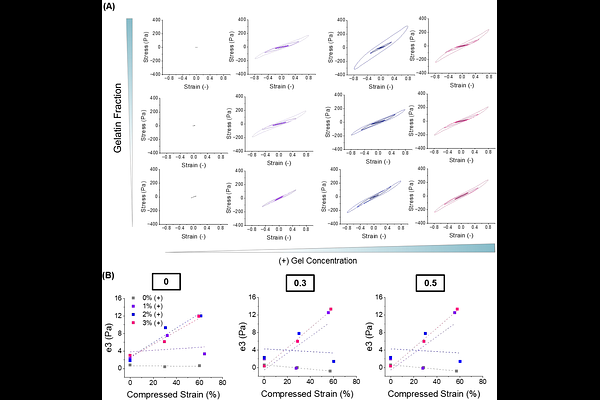An injectable granular hydrogel stabilized by electrostatic interactions between hyaluronic acid-based microparticles and soluble gelatin exhibits poroelasticity and strain-stiffening

An injectable granular hydrogel stabilized by electrostatic interactions between hyaluronic acid-based microparticles and soluble gelatin exhibits poroelasticity and strain-stiffening
Tumbic, J.; Highley, C. B.
AbstractInjectable hydrogels with shear-thinning and self-healing properties are critical for biomedical applications including 3D bioprinting and regenerative medicine. While granular hydrogels inherently exhibit these properties, they often lack post-injection stability. Here, we developed an electrostatically stabilized granular hydrogel system composed of norbornene-modified hyaluronic acid (NorHA) microgels and cationic gelatin ((+) Gel). NorHA microgels (9.91 +/- 4.85 m diameter) were synthesized via batch emulsification, while (+) Gel was prepared by modifying gelatin with ethylene diamine to increase zeta potential from 2.08 +/- 0.97 mV to 13.76 +/- 1.11 mV. The negatively charged NorHA microgels formed stable materials when combined with (+) Gel through electrostatic interactions, confirmed by gel inversion tests and salt sensitivity studies. Rheological characterization revealed that (+) Gel addition produced poroelastic behavior and strain-stiffening properties, with storage modulus and yield onset increasing under compression. Large amplitude oscillatory shear analysis showed strain-stiffening behavior (e3 > 0) that enhanced with both (+) Gel concentration and compression. Confocal microscopy demonstrated tunable porosity through gelatin fraction control, with (+) Gel forming aggregate-like clusters. Extrusion testing showed formulations required low injection pressures (0.47-0.91 kPa) comparable to PBS and significantly lower than Pluronic, while forming robust filaments up to 23 mm in length. The materials exhibited rapid self-healing behavior and maintained structural integrity post-extrusion. This electrostatically stabilized granular hydrogel system offers a promising platform for injectable biomaterials that combine ease of delivery with post-injection stability for wound healing and 3D bioprinting applications.